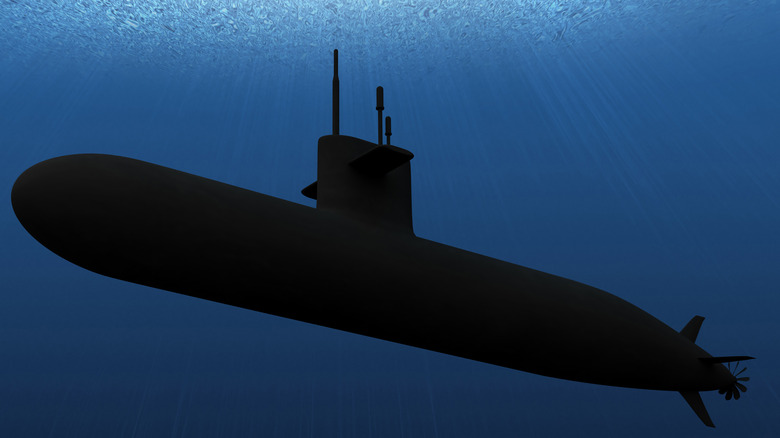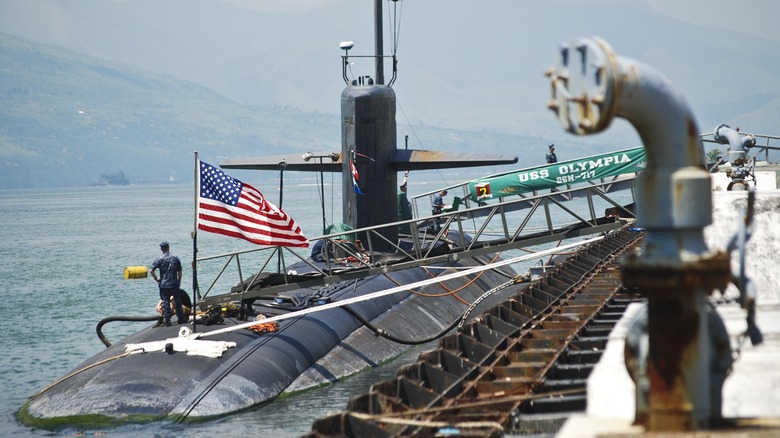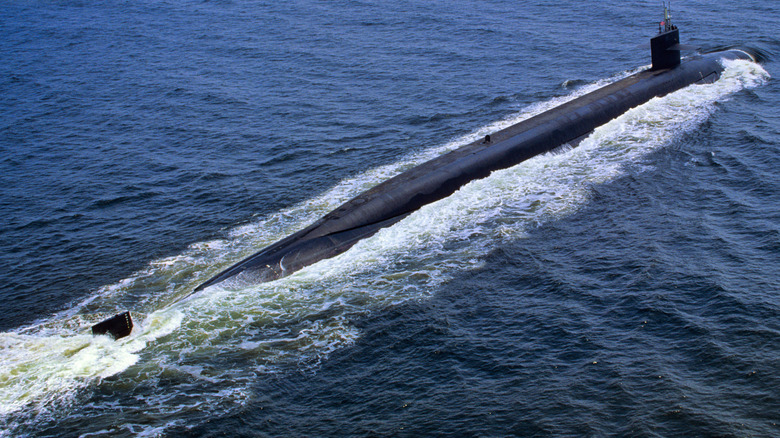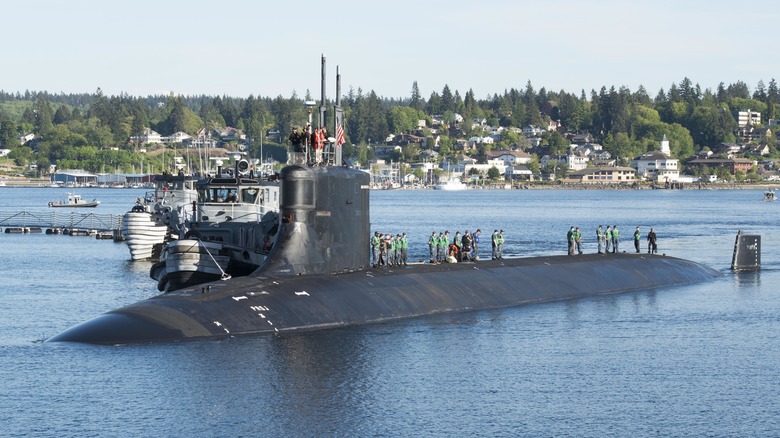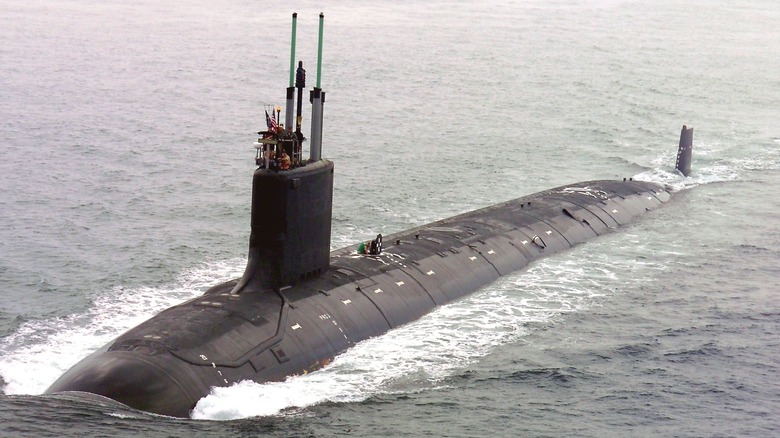The US Navy's Submarine Fleet Is Bigger Than You Think
Thanks to movies like "Crimson Tide," when most people think of the United States Navy's submarine force, they remember the Ohio-class submarines. While Ohio-class subs make up a portion of the submarine force, they're hardly the most used subs in the service. There are currently four classes of submarines in the Navy, and they vary in function, from fast attack to various types of missile submarines.
The U.S. Navy's submarine force currently consists of 71 submarines. These days, all of the United States' submarines are nuclear-powered, having stopped using diesel-powered subs with the retirement of the USS Dolphin (AGSS-555) in 2007. This makes it possible for a sub to operate for as long as needed, and they only need to return to port to add provisions or transfer personnel, and means that a U.S. submarine can stay submerged for months at a time.
In terms of missions, the various submarines that make up the fleet undertake a variety of operations. Some remain hidden beneath the waves to be used in the event of nuclear war, while others patrol the world's oceans, looking for potential targets while ideally remaining undetected. The 71 submarines in the fleet are operated by thousands of submariners, and every one of them serves a vital function in the U.S. military's global operations. These are the boats upon which they serve.
Los Angeles-class fast attack submarines
The U.S. Navy's fleet of Los Angeles-class fast attack submarines (SSN) has been the backbone of the submarine fleet for decades. The now decommissioned USS Los Angeles (SSN-688), the first of its kind, was commissioned in 1976, and over the life of the program, the Navy operated 62, though only 25 remain in service. They make up more than half of the fast attack submarine fleet, and each one is named after an American city.
Los Angeles-class submarines are powered by a nuclear reactor that propels the vessel to a maximum speed of 25 knots (29 mph). They require refueling after around 10 years and are manned by 16 officers and 127 enlisted personnel. In terms of armaments, each sub features four 21-inch torpedo tubes, Tomahawk land attack missiles, Harpoon anti-ship missiles, and a complement of deep-water anti-submarine mines. Like other Navy vessels, Los Angeles-class subs have undergone massive refits and redesigns for modernization.
Upgraded models feature 12 vertical launching system tubes to fire Tomahawk missiles at targets up to 1,500 miles, so the subs are deadly on both land and sea. Los Angeles-class submarines were built for one purpose: to counter the threat posed by the Soviet Union. While the threat never fully manifested, Los Angeles-class submarines have taken part in U.S. military operations around the globe. Due to their age, the Navy is actively replacing its aged fleet of Los Angeles-class subs with newer Virginia-class submarines.
Ohio-class ballistic missile and guided missile submarines
The Ohio-class submarine is one of the most important in the fleet, as it's responsible for delivering nuclear missiles to targets anywhere in the world. Hopefully, that will never happen, but having Ohio-class submarines as part of the Nuclear Triad and a deterrent to outside aggression makes them the best unused weapons in the U.S. arsenal. The Navy initially planned for 24 vessels but stopped with 18, all of which remain in service.
Of the 18 Ohio-class submarines, 14 carry 24 Trident II intercontinental ballistic missiles (ICBM). Each missile is capable of carrying up to eight nuclear warheads of varying yields with a range of up to 7,100 miles, though various sources note different ranges. The USS Ohio (SSGN-726) was the first to be commissioned in November 1981, and it remains active to this day. There are two types of Ohio-class submarines based on their configuration. There are 14 guided-missile submarines (SSBN) that carry nuclear weapons, and four ballistic missile submarines (SSGN).
The Navy's fleet of SSGNs is configured to carry cruise missiles instead of ICBMs. Each sub carries 154 Tomahawk land-attack cruise missiles, and 22 are loaded into the sub's launch tubes for immediate use whenever necessary. Technically, SSGNs are still capable of carrying and firing ICBMs, but they aren't utilized for that purpose. Instead, they function as land-attack platforms with an extensive stand-off distance, making them lethal while remaining safe at sea.
Seawolf-class fast attack submarines
The Seawolf-class submarine fleet is the smallest in the Navy's inventory, with only three boats having been built. Initially, 29 were ordered, but the Navy canceled the program due to the end of the Cold War. All three remain active fast attack submarines (SSN) operating in the world's oceans today. The USS Seawolf (SSN-21) was commissioned in July 1997 and was assigned to the U.S. Atlantic Fleet.
Seawolf-class submarines are fast, achieving a maximum speed of 35 knots (40 mph), so they're not called "fast attack submarines" for nothing. Each sub is outfitted with a nuclear reactor, and they're manned by 14 officers and 126 enlisted personnel. Seawolf-class subs may not have gone into mass production, but they changed submarine warfare via their speed and stealth. In terms of armaments, each sub features eight 26" torpedo tubes, Tomahawk land attack missiles, anti-ship missiles, and guided torpedoes.
One of the three Seawolf-class submarines, the USS Jimmy Carter (SSN-23), is unlike the others. The Carter is around 100 feet longer than its sister boats, allowing for the insertion of the Multi-Mission Platform. This enables the sub to launch remotely operated underwater vehicles (ROV) operated by Navy SEALs on clandestine missions. The modification cost $887 million and likely made it possible for the Carter to tap undersea fiber optic cables, making it the only vessel capable of doing so.
Virginia-class fast attack submarines
The Virginia-class fast attack submarine is the newest model in the Navy's undersea fleet. Virginia-class boats were designed to be smaller and faster than their predecessors, which they're actively replacing in the inventory. As of mid-2024, 22 Virginia-class submarines have entered into active service. The Navy has more on the way, with ten under construction and an additional four on order. Once they enter service, Virginia-class submarines will make up the bulk of the Navy's submarine fleet.
The USS Virginia (SSN-774) was commissioned in October 2004, and the Virginia class became the most technologically advanced ever constructed. Virginia-class subs move through the water at over 25 knots (28.7 mph), powered by its nuclear reactor. The boat's complement consists of 15 officers and 120 enlisted personnel. There are five blocks with varying armaments, with the newest, Block V, featuring 12 tubes for Tomahawk cruise missiles and four 21" torpedo tubes, planned for future boats.
In total, a Virginia-class submarine can carry between 25 and 65 torpedoes and missiles, each of which makes the vessel incredibly lethal in undersea warfare. Virginia-class submarines' nuclear reactors output a ton of energy (30 megawatts), and future plans may incorporate the addition of a high-energy laser weapon on the periscope mast capable of emitting a beam powered to 300-500 kilowatts. Should this be incorporated, the laser will likely function as a defense against aircraft, though it's unclear when — or if — this will happen.
[Featured image by U.S. Navy via Wikimedia Commons | Cropped and scaled | Public Domain]
